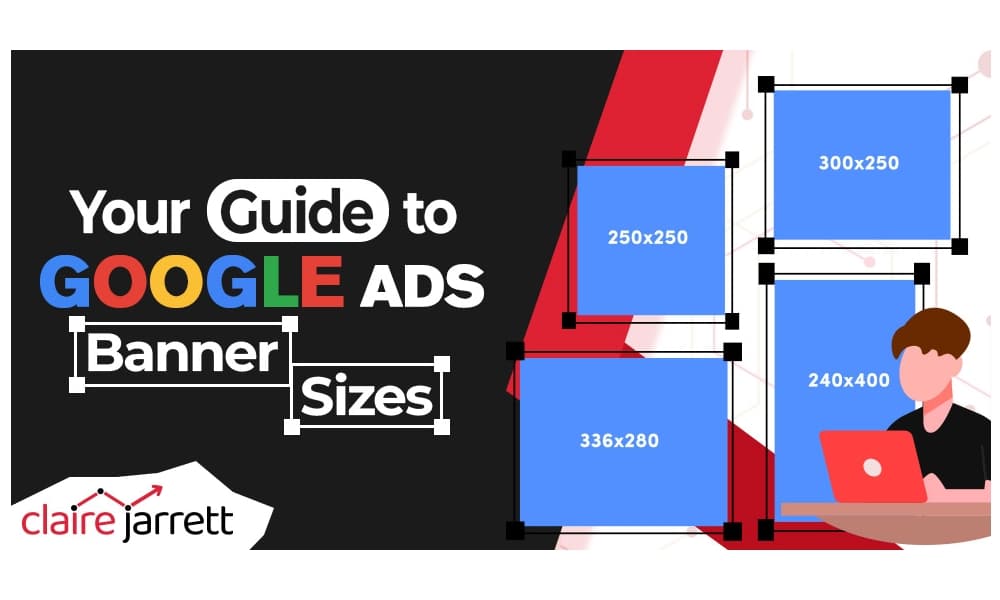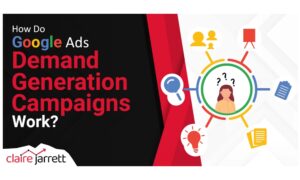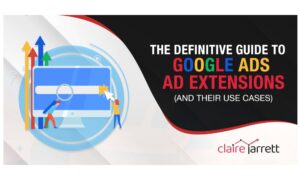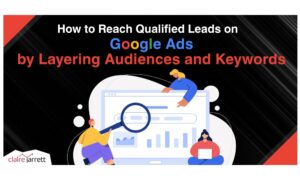The Ultimate Guide to Google Ads Banner Sizes [Updated For 2025]

Last Updated on: 24th January 2025, 05:38 pm
There’s nothing worse than creating the right Google Ads banner, only to upload it and realise it’s the wrong size. So before you hit “Save” in Photoshop or Canva, make sure you’re choosing the right Google Ads banner size for 2025!
In this article, I’ll show you the updated specs, as well as best practices you should follow to get more mileage out of every banner.
Let’s dive in!
What Are the Most Common Google Display Ad Sizes?
I often talk to Google Ads coaching clients, only to realise they’re using “banners” and “display ads” interchangeably. If that’s where you’re coming from, let me make sure you have the correct information.
The following are the most commonly used display ad sizes in 2025 campaigns, with a few tips on when to choose them:
- Square (250 x 250): This square-shaped ad fits nicely into different ad spaces.
- Small Square (200 x 200): This smaller version is perfect for more compact ad spaces.
- Banner (468 x 60): This long and narrow option works well at the top or bottom of pages.
- Leaderboard (728 x 90): If you want to grab attention, use the leaderboard ad size – the horizontal ad you can often see at the top of the page.
- Inline Rectangle (300 x 250): The inline rectangle ad slots within the page’s content, but it can be distracting, so tread carefully (or use it exclusively for your remarketing campaigns).
- Large Rectangle (336 x 280): The large rectangle is a good choice if you need more room for your message or creative presentation.
- Skyscraper (120 x 600): The tall and narrow skyscraper ad stands out on the side of the pages.
- Wide Skyscraper (160 x 600): Similar to the regular skyscraper, this wider version provides more space for content.
- Half-Page Ad (300 x 600): Think of the half-page as the centrefold – it’s a larger canvas for your offer.
- Large Leaderboard (970 x 90): Even bigger than the half-page ad, the leaderboard is fantastic for those truly remarkable offers.
Mobile Display Ad Sizes
Turning over to mobile, we typically use the following Google display ad sizes:
- Mobile Banner (300 x 50)
- Mobile Banner (320 x 50)
- Large Mobile Banner (320 x 100)
Responsive Display Ad Sizes
If you want your Google Ads to automatically adjust to different devices, you’ll want to check out responsive Google ads – responsive display ads, in particular.
All you have to do is upload images in square (1:1) and landscape (1.91:1) aspect ratios. Then, Google will reformat them to fit on different screens, depending on who’s viewing them.
The most commonly used responsive mobile ad sizes include:
- 330 x 200
- 300 x 50
- 300 x 100
- 250 x 250
- 200 x 200
Responsive Display Ad Sizes for Mobile
And on the desktop side of things, we typically use the following sizes:
- 300 x 250
- 250 x 250
- 336 x 280
- 200 x 200
- 300 x 600
- 160 x 600
- 970 x 90
- 728 x 90
- 468 x 60
Note: These sizes refer to the displayed ads, not the images you upload.
What Are the Best Performing Google Ads Display Sizes?
Now, every PPC consultant has their own favourites. However, I swear by the following Google Ads display ad sizes when working with my clients (although your mileage may vary):
- Medium Rectangle (300 × 250): Since the medium rectangle is within text content and articles, it’s highly visible. Again, be careful – I typically use these for my remarketing campaigns, where they’re more effective than as first touchpoints.
- Large Rectangle (336 × 280): Since the large rectangle is rather large, it gives you plenty of room to describe your offer – whether textually or visually, which can be an asset in many Google Ads campaigns.
- Leaderboard (728 × 90): Since leaderboard ads are placed prominently on top of the page, they instantly grab attention, so they’re a good option for brand awareness campaigns.
- Half Page (300 × 600): If your offer is terrific, why not occupy more space with your message? Again, try to be as creative as possible and really emphasise why your option is better than the competitors, so you maximise the attention’s worth.
- Large Mobile Banner (320 × 100): Everything looks small on mobile, and so do ads. Go with a larger banner to grab extra visibility!
Best Practices for Google Ads Banners and Display Ads
Creating a good Google Ads banner goes beyond choosing the right amount of pixels. Make sure you incorporate the following into your design to see the ROI boost:
- Keep your ad simple: Use high-quality images and concise text to grab attention quickly. Avoid overcrowding your ad with too many elements – yes, that Canva element is adorable, but do you really need it?
- Use a strong value proposition: Highlight why your product is better than your competitors in as few attention-grabbing words as possible. For example, when I first started promoting my company through Google Ads in 2008, I incorporated everything my competitors offered – and then some.
- Use a strong CTA (call to action): Add a sense of urgency and actionable words like “see,” “try,” or “watch.” These motivate the viewers to take action.
- Don’t cast a wide net: My good old rule is – one audience segment? One ad group. If you’re dealing with different segments, each should have a dedicated ad, creative, and landing page, so your Quality Score rises, and your CPC decreases.
- A/B test your Google Ads banners: Experiment with ad variations to find the right one. There will be a learning period during which Google will test your campaigns, but you’ll get much more precise data. Double down on what works to scale your campaigns.
- Use the customisation options: Google Ads offers plenty of options to customise your responsive display ads, including changing the colours. Don’t go overboard, but by all means – make sure the ad completely matches your brand for recognition.
Ready to Hit the Launch Button?
Now that you’re 100% sure how big your banner can be, it’s time to roll up your sleeves and get to work!
Just remember: creating a nice visual is only one part of campaign optimisation. Google Ads can bring about a significant increase in ROI, but only if you do it right. Spend twice as much time understanding the mechanisms behind the platform as you spend creating the ad.
And if you need assistance, get in touch with me. For quick help with effective campaign setup, get your copy of my best-selling Google Ads book and launch a profitable campaign in 7 rapid steps!








